The 2013 MacBook Air Review (13-inch)
by Anand Lal Shimpi on June 24, 2013 12:01 AM ESTThe GPU: Intel HD 5000 (Haswell GT3)
Hire enough ex-ATIers and you’ll end up really caring about GPU performance apparently. It’s good to see that Apple still views increasing GPU performance as non-negotiable, even at the MacBook Air level. Discrete GPUs are out of the question in the MacBook Air, so all models ship with Intel’s on-die processor graphics. More importantly, all CPU choices integrate the largest GPU offering: Intel’s HD 5000 (aka GT3).
Clock speeds alone prevent the 40 EU GPU implementation from being called an Iris 5100. Given the 15W TDP limit, Intel wouldn’t be able to do the Iris name justice even if it tried.
It’s hilarious that Intel refused to give out die photos for anything other than quad-core Haswell GT2, citing competitive concerns, yet at Apple’s WWDC launch of the new MacBook Airs we got to see the first die shot of a dual-core Haswell GT3. Update: I stand corrected. Intel posted its own shot here.
From the die photo it’s very obvious that like the quad-core Haswells with Iris Pro, the dual-core GT3 parts are over half GPU. Here's the only Haswell die shot Intel PR officially released by comparison, a quad-core GT2 part that's mostly made up of CPU cores:
Similar to the CPU discussion, on the GPU front Haswell has to operate under more serious thermal limits than with Ivy Bridge. Previously the GPU could take the lion’s share of a 17W TDP with 16 EUs, now it has 15W to share with the PCH as well as the CPU and 2.5x the number of EUs to boot. As both chips are built on the same 22nm (P1270) process, power either has to go up or clocks have to come down. Intel rationally chose the latter. What you get from all of this is a much larger GPU, that can deliver similar performance at much lower frequencies. Lower frequencies require lower voltage, which in turn has a dramatic impact on power consumption.
Take the power savings you get from all of this machine width, frequency and voltage tuning and you can actually end up with a GPU that uses less power than before, while still delivering incrementally higher performance. It’s a pretty neat idea. Lower cost GPUs tend to be smaller, but here Intel is trading off die area for power - building a larger GPU so it can be lower power, instead of just being higher performance.
| A Historical Look at MacBook Air GPU Performance | |||||||||
| 2011 | 2012 | 2013 | |||||||
| GPU | Intel HD 3000 | Intel HD 4000 | Intel HD 5000 | ||||||
| Manufacturing Process | 32nm | 22nm | 22nm | ||||||
| Frequency | 350/1150MHz | 350/1050MHz | 200/1000MHz | ||||||
| Cores | 12 | 16 | 40 | ||||||
| Peak GFLOPS | 165.6 GFLOPS | 268.8 GFLOPS | 640 GFLOPS | ||||||
| TDP | 17W | 17W | 15W | ||||||
This is an even bigger deal because few of the other OEMs seem interested in paying for the larger die. Acer’s S7 uses Intel’s HD 4400 (Haswell GT2, 20 EUs), as do most of the other Haswell Ultrabooks that have been announced thus far. Armed with a 2011, 2012 and 2013 MacBook Air as well as Acer’s 2nd generation S7, we now have the ability to compare everything from Intel’s HD 3000 (Sandy Bridge) all the way up to HD 5000. It’s important to keep in mind that with the exception of HD 3000, everything here is built on the same 22nm process, and with HD 4400/5000 TDPs actually went down. In other words, post Ivy Bridge, any GPU performance gains were very hard to come by.
I’m splitting up the GPU performance data into three sections. The first is a look at some games/settings that are actually playable on processor graphics. The second is comparison data for laptop Bench. The deltas here are academic at best since nothing slower than Iris Pro can really deliver playable frame rates in our high-end notebook GPU tests. The final section focuses on synthetic performance, which should help characterize the peak theoretical gains you can expect from HD 5000.
All of the gaming tests were run under Boot Camp/Windows 8. I think it’s time to retire the HL2/Portal testing under OS X.
Playable Gaming Performance
There's a surprising number of games that are actually playable on Intel's HD 5000 in the MacBook Air. You have to be ok with the fan spinning quite loudly, but it's possible to get some ultra portable gaming in if you're up for it.
For all of these tests I stuck with 1366 x 768 so I could run comparable data on the only HD 3000 equipped MBA I had, an 11-inch model. I also threw in data from Inte's HD 4400 using the new Haswell equipped Acer S7. I'll start with GRID 2, a brand new racer, running at relatively low quality settings.
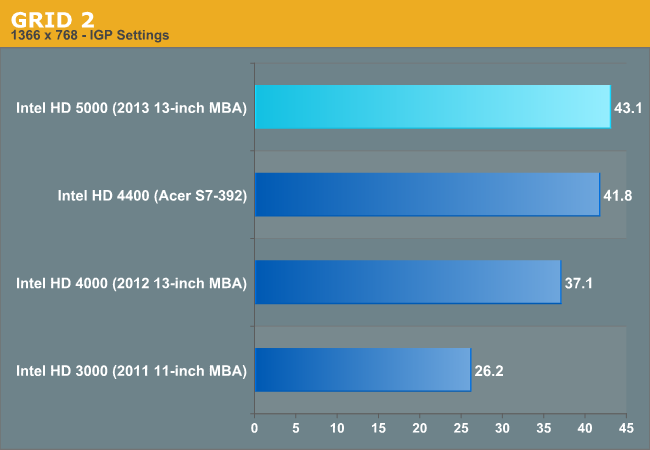
GRID 2 is absolutely playable on the new MacBook Air. At 43.1 fps it's 16% faster than last year's HD 4000 model. A 16% gain without increasing TDP on the same manufacturing process is pretty impressive. The gains over the 2011 MBA are substantial. GRID 2 goes from almost playable to fast enough where you can actually turn up some of the quality settings if you wanted to.
Next up is Borderlands 2. Again, a fairly modern title, but one that's really optimized for current generation consoles - making high-end processor graphics more than up for the task. While a higher TDP implementation of Haswell's integrated graphics wouldn't have an issue here, things are a little more difficult with a 15W TDP.
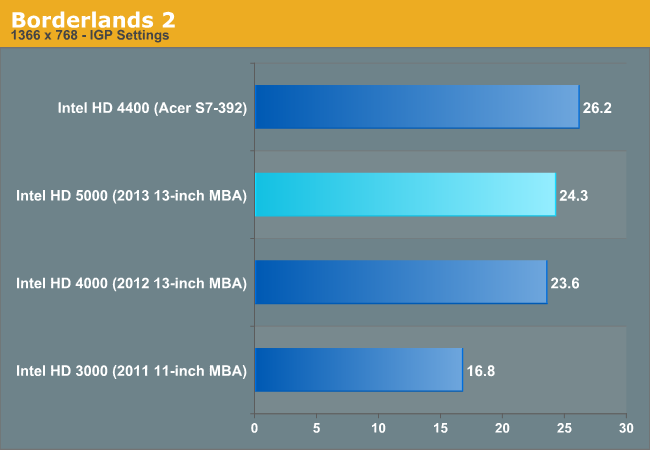
We see a marginal improvement over the HD 4000, we're clearly thermally bound at this point. What's interesting is the HD 4400 on the S7 is actually quicker here. The difference could be cooling or how Apple decides to scale back on GPU frequency when faced with thermal limits. A quick look at Haswell's power reporting confirms that while running my Borderlands 2 test the GPU was already exceeding the PL1 (Power Limit 1) of 15W:

Remember, with Sandy Bridge Intel introduced Turbo Boost 2.0 that effectively allowed for two separate power limits - one equal to the processor's TDP (PL1) and one higher than the processor's TDP (PL2) that could be hit as long as the die temperature doesn't get too high.
Despite the sub 30fps frame rate in this benchmark, Borderlands 2 was definitely playable on the HD 5000. It wasn't always smooth but if you need your single player fix, it'll suffice.
I've had a few requests to bring back our Minecraft benchmark. We ditched it from our higher end GPU reviews since it's no longer stressful enough, but for 15W TDP iGPUs it's perfect.
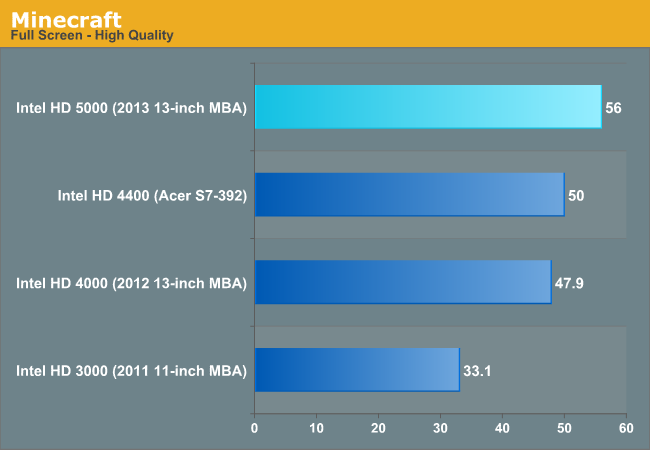
Once again we see almost a 17% increase over Intel's HD 4000. The HD 4400 comparison is also very impressive with a 12% increase in performance vs. what most MBA competitors will be using.
When I was a kid all I wanted was a console that could play arcade quality ports of Street Fighter II and Mortal Kombat II. These days, even the latest Street Fighter title has no issue playing on free graphics:
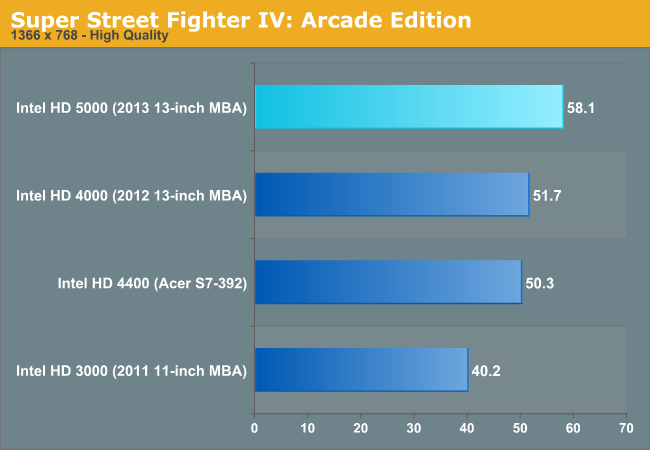
16% seems to be the magic number as that's exactly how much faster HD 5000 is compared to HD 4000. Given the lower TDP this year, that's a pretty reasonable gain. Looking at the sheer number of transistors that had to be used to get there however gives you good insight into just how hard it is to improve performance without a corresponding process node shrink.



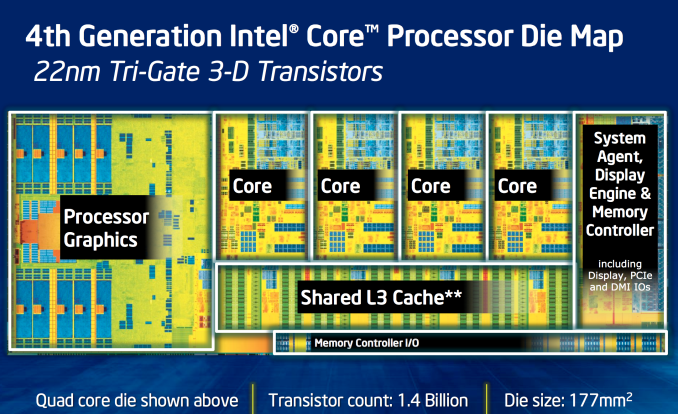
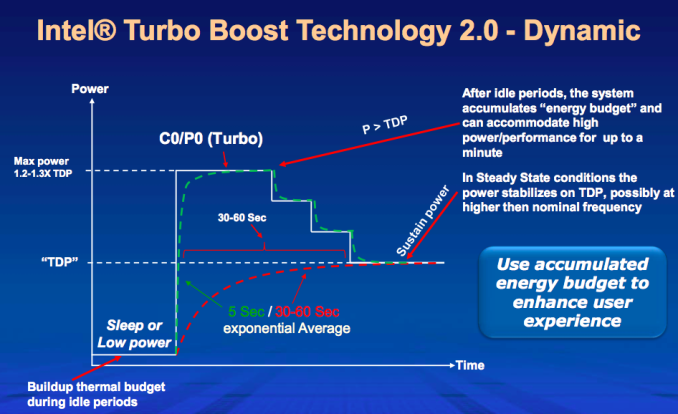








233 Comments
View All Comments
AKfaust - Friday, June 28, 2013 - link
So I purchased one of the base units early this week and am very happy so far. The performance is great and surprisingly I can run Civ V, LOTRO, etc at some pretty decent settings without a hitch.custompc - Thursday, July 4, 2013 - link
XPS13 indeed a better option.http://custompcshop.net
darwinosx - Monday, July 8, 2013 - link
No its cheap Dell junk with poor support and it run Windows.Blindsay - Tuesday, July 16, 2013 - link
So i would say the only thing that dissapoints me about the screen are the viewing angles. I find the resolution of 1440x900 quite fine for a screen of this size but i am spoiled by the viewing angles of my IPS screens. Other than that i am quite happy with my MBA so far (i7 8GB, 256GB)Risas - Thursday, July 18, 2013 - link
Macs vs Macs... what a usefulness comparisons. Is the Mac from 2013 better than the one from 2011? I hope so!When will you compare the ultrabooks in stores now against the Macs? Some comparison like "what you get for that price"... Maybe some people could find some good ideas for spending their money... Not just Macs against Macs as there was no other option in the world... inbreeding?
gentux - Friday, July 26, 2013 - link
Good review. One thing I noticed was that the speakers are much better than on the 2011 MacBook Air. I have no idea if this was already improved in 2012 but the 2013 really rocks and actually has a nice bass. I think they haven't been stereo in the past.lobisme11 - Tuesday, August 6, 2013 - link
This computer is simply amazing if I could change on thing it would be to add retina display. However the screen resolution is still great! The battery dosen't last the 12 hours it is supposed to when editing movies/videos which is what I use it for. For typing/surfing the web the battery is great! Some times while editing a movie the computer freezes normally for about 30 seconds however it rarely ever has to be restarted when it freezes. Overall Simply Amazing! A definite Buy! Great phone support to. Buy a warranty Overall: 8.5/10antonio22m - Saturday, August 10, 2013 - link
Macbook Air is undoubtedly a very good notebookPrice and lack of optical drive can affect a large number of users whose decision during the judgment can be negative so that they can decide to choose another manufacturer.
Air is perfect and the best "second computer" that you can wish for.
His task was not to be the main and only computer we can possess.
If you want excellent laptop computer that will be able to carry it with you wherever you go, the Air is an excellent choice for perfectly reasonable size and more pronounced weight that barely exceeds one kilo.
Take a look at this comparison at http://www.squidoo.com/apple-macbook-air-133 and You will see comparison to the another Apple laptops.Anyone considering purchasing this laptop needs to see the information in this chart.
strafejumper - Tuesday, August 20, 2013 - link
I went to the apple store to get this haswell macbook air but the tn panel - while good for a tn panel - looked bad next to all the iphones, mini ipads, and ipads all around itTo me an ultrabook should not have a tn panel - i couldn't buy it
The Macbook pro 13" was too heavy (and i cannot wait for the impending refresh)
It's really tough though because the windows ultrabooks (only 2 out so far - Sony Pro and Asus S7) have half the battery life of the macbook air.
Half! My guess is this is mostly due to Mac OS and Mavericks isn't even out yet!
If the Macbook air had an IPS I think it would be a slam dunk -
As it is I think i'm going to be stuck with a crappy 6hr Sony Vaio
thinkpanda - Friday, September 13, 2013 - link
Apple delivered an update of OS X (10.8.5) which claim to fix the file transfer speed with 802.11ac network. Would Anand update the test result with that path?